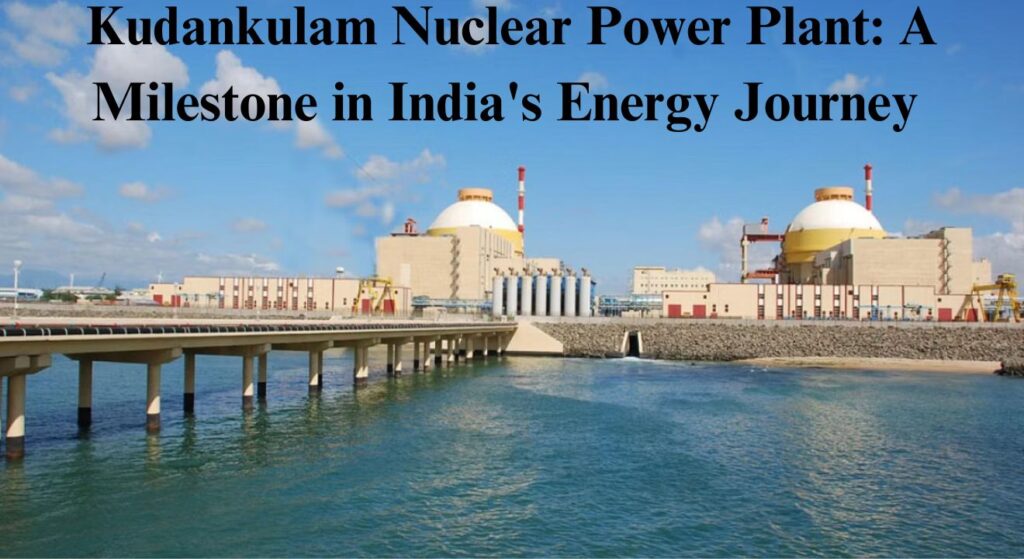
Kudankulam Nuclear Power Plant (KNPP) is India’s largest nuclear power plant. This power plant was built with the help of Russia and is a symbol of India’s increasing capacity to produce peaceful energy. Since its inception, this plant has been making an important contribution to India’s nuclear power generation and is also becoming a topic of democratic opposition.
History Of Kudankulam Nuclear Power Plant:
The idea of building the Kudankulam Nuclear Power Plant started in 1988 with an inter-governmental agreement between India and the Soviet Union, now known as Russia. But, due to some internal disputes and political and economic changes in the Soviet Union at that time, the project got delayed for a long time. Finally, the project was started in 2001.
Why Did People Protest Against Kudankulam Nuclear Power Plant?
The protest against Kudankulam Nuclear Power Plant started in 2011. People were afraid that the construction of this plant would harm the environment, there was a great fear of people’s lives being in danger due to a nuclear accident and of losing their livelihood. This is how the protest against KNPP started.

1. Fear Of Nuclear Accident
After the Fukushima nuclear disaster in Japan in 2011, there was a lot of fear and worry among people that a similar incident could happen in Kudankulam. People there believed that if a nuclear accident occurs, it could lead to radiation exposure, diseases like cancer and loss of many lives.
2. Environmental concerns
People also feared that the plant could cause damage to the environment. They believed that the plant would depend on the land and water resources there, which could destroy agriculture and fish farming. Kudankulam is near the coast, so there was also a risk of natural disasters like tsunami and earthquake.
3. Impact on employment and livelihood
Fish production was in large quantities in the area around Kudankulam, which became a source of employment for the fishermen there. The people there was afraid of the plant being built because the hot water from the nuclear plant will go into the sea and kill the fishes, which will take away their employment.
4. Lack Of Knowledge
The government did not provide complete information to the people regarding the construction of the nuclear power plant in Kudankulam, due to which people did not know the safety measures of building the plant and the benefits and disadvantages that would arise from it. Due to this also people protested in the absence of information. If the government had given the right instructions, this protest would not have happened.
When Did The Protests End?
Under the direction of the People’s Movement Against Nuclear Energy (PMANE), hundreds of locals, including farmers and fisherman, actively participated in the 2011–2012 protests, which peaked in size. However, by the middle of 2013, a number of reasons, including the following, had combined to cause the protests’ intensity to decline:
- In an effort to scatter protestors, the administration sent out large police units, which occasionally resulted in arrests and violent incidents.
- In May 2013, the Indian Supreme Court declared that the plant was both safe and essential for meeting the nation’s electricity demands. With this legal support, the government was able to move on with the project.
- The Kudankulam plant’s first reactor was put into service in October 2013 in spite of the demonstrations. This was a watershed moment since the government declared that the plant would go into operation in spite of resistance from the local community.
Even after 2013, protests persisted sometimes, but their impact was not as significant as it had been previously. Most of the resistance had faded by 2014.
What Was The Result Of the Protests?
The main objective of the protests, to shut down the Kudankulam Nuclear Power Plant, was not accomplished. Still, there were a few noteworthy results:
- The demonstrations raised awareness of nuclear safety, environmental effects, and local people’ worries about large-scale infrastructure projects on a national and international level.
- The government and plant administrators informed the public that the facility had stricter safety measures, even though the plant was eventually put into service. In part in reaction to public concerns, there was a greater emphasis on safety inspections and communication regarding catastrophe preparedness.
- The distrust between the government and the local communities grew as a result of the protests. Locals have a persistent sense of dissatisfaction because many believed that their issues were not sufficiently addressed.
- The Kudankulam Nuclear Power Plant has grown to be one of India’s biggest nuclear power plants in operation in spite of the demonstrations. Several units have been brought online after the first unit went online in 2013.
Even though the local communities still feel their voices were largely ignored, the Kudankulam protests helped draw attention to nuclear safety concerns and prompted the government to engage more openly on these issues, even though they did not stop the nuclear plant from going into operation.
Current Status and Capacity of Kudankulam Nuclear Power Plant
KNPP currently contributes significantly to India’s electrical grid. The plant now has two 1,000 MW operational units, and plans are in place to add more reactors that are currently being built as part of an expansion.
1. Unit 1
Unit 1 started up and tested first before going into commercial operation in 2014. Ever since then, it has been supplying the southern grid with a consistent amount of electricity.
2. Unit 2
A few years later, the second unit was also finished and put into service, increasing India’s nuclear power output even more.
3. Future Plans
As part of a long-term goal to increase India’s nuclear energy capacity, Russia and India have worked together to build further reactors at the same location. Additional units are currently being built.
The Kudankulam Nuclear Power Plant is evidence of India’s increasing proficiency with nuclear technology and its determination to broaden its energy portfolio. Despite resistance and difficulties in 2012, it has since developed into an essential component of India’s energy infrastructure, assisting the country in meeting its electricity needs and advancing the country’s ambitions for greener energy.
